Trudy J. Morgan-Cole's Blog, page 4
August 2, 2025
Louise and Vincent, by Diane Byington
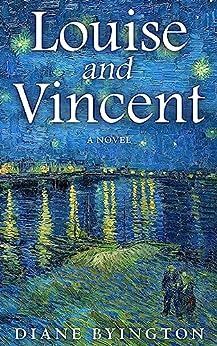
This was a pretty enjoyable historical novel based on the theory (considered extremely unlikely by most historians) that Vincent van Gogh didn’t kill himself, but was shot by someone else. The novel creates a backstory for the murder that involves a secret affair between Vincent and the wife of the hotel manager in the last place he stayed. While Louise was a real person, the details of her life, especially the affair with van Gogh, are imagined for this story. It’s an interesting kind of “what if” story for those who are interested in van Gogh’s life and are open to a re-imagining of his last months in a way that doesn’t stick strictly to known historical fact.
June 30, 2025
The Saltbox Olive, by Angela Antle

I was delighted to get my hands on a copy of Angela Antle’s debut novel The Saltbox Olive when it was released a couple of weeks ago, for two reasons. One is because I love great historical fiction, especially if it unlocks a piece of history I haven’t been previously familiar with. But the second is more personal: several years ago, in the pre-pandemic times, I was privileged to read and give some feedback on a much earlier version of this novel, when Angela and I were paired in WritersNL’s mentorship program.
To say that I was ever Angela Antle’s mentor seems a bit of a stretch now, as she is such an accomplished and polished author. While this is her first foray into fiction, Antle is already well-known in Newfoundland as a journalist and documentarian, as well as a visual artist. This book has been through many years of work and revision since I read that early draft of it, and the author’s craftsmanship is evident on every page.
The little-known story that unfolds in these pages is that of the Newfoundlanders who fought in North Africa and Italy in the Second World War. In the First World War, the small island country of Newfoundland raised its own Newfoundland Regiment (later the Royal Newfoundland Regiment) to fight overseas. This was not possible by the outbreak of World War Two in 1939, when Newfoundland had given up its independence due to bankruptcy, and returned to British colonial status under Commission of Government rule. Despite the Commission not raising its own Newfoundland force, many Newfoundlanders individually chose to enlist in either the British or Canadian armies, navies, or air forces (and some, who could claim US connections, like a great-uncle of mine, fought in the US armed forces). The Newfoundland men who joined the British army mostly served in either the 59th (Newfoundland) Heavy Regiment, or the 166th (Newfoundland) Field Regiment.
It’s the story of the men of the 166th and their time in Italy that’s explored in this novel. Like her contemporary main character, Caroline Fisher, Antle has a family connection to the 166th. The story of this regiment is not well known in Newfoundland today, although it’s been told in two non-fiction books: Gunners World War II: 166th (Newfoundland) Field Regiment Royal Artillery, a pictorial history by Edward Chafe, and Perhaps They Left Us Up There, a personal account by 166th veteran Harold Lake. Those accounts were published 38 and 30 years ago respectively, and both are out of print. Though Newfoundlanders love a good war story, neither a compelling non-fiction writer nor one of our many novelists has taken up the tale of the 166th — until Angela Antle turned her hand to it.
But The Saltbox Olive is so much more than just a story of soldiers fighting far from home — though it’s that as well. It’s a bittersweet family story about two brothers, Arch and Garl Fisher, who can’t escape the heritage of a painful home life. But the story extends beyond these two men to include not just some of the other soldiers in the regiment, but also a Newfoundland woman, Barbara, who ambitious to become a war photographer despite the fact that nobody believes a woman can do that job, and Lucia, an Italian partisan who is committed to her country’s freedom but even more to protecting her son Cosimo. We see the conflict through a variety of different lenses, as well as through the modern-day story of Caroline, who is piecing together the fragments of family history through her research. All these stories are brought together with a deft and sure hand in the novel’s closing pages, offering a satisfying and heartfelt ending.
The Saltbox Olive is a novel that feels like a mosaic or a stained-glass window – bright shards of the Second World War experience from a variety of unexpected perspectives – that come together to form a vivid whole. This is an immersive, shining novel that took me to places I never expected to visit. Not only is it the best book by a local writer that I’ve read so far this year, it is — in a year already full of great historical reads including Jo Harkin’s The Pretender and Robert Harris’s Act of Oblivion — one of the best historical novels I’ve read in 2025. I recommend it very highly.
June 29, 2025
Cautiously Pessimistic, by Debbie McGee
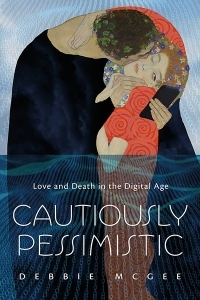
Cautiously Pessimistic is a lot of different things, as its subtitle (Love and Death in the Digital Age) implies. It’s a raw, honest memoir about a loving but in some ways unconventional marriage; it’s an equally raw and honest account of what it’s like to go from receiving your partner’s cancer diagnosis to saying goodbye to them within a period of eight months; it’s an exploration (often more implicit than explicit) of how living in the era of social media impacts the way we experience relationships, loss, and grief.
Debbie tells the wonderfully heartfelt story of how she met, fell in love with, fell out of love with, had a child with, got back together with, had another child with, and (much later) eventually married Gerry Porter. This aspect of the story is filled with scenes that evoke vivid memories for anyone who lived in St. John’s in the 1990s and was even peripherally aware of the downtown arts scene. It’s not just the deliciously gossipy name-dropping of people we either know or know of; it’s little details like Debbie mentioning a place where she and a friend went to eat, and the sudden shock of recognition: “I remember that restaurant! I’d forgotten it ever existed!” Even if you didn’t live in St. John’s, if you were once young, and fell in and out of love, and made a few bad decisions, and either lived, or wished you were living, an artsy bohemian lifestyle, you’ll relate to parts of this memoir.
The brilliance of this story is in not telling it chronologically — or rather, alternating one chronological story with another. Each time you finish a chapter in Debbie’s and Gerry’s turbulent youthful relationship, you find yourself in another chapter in which they are mature married people, parents of two grown sons, their comfortable life in retirement suddenly derailed by Gerry’s terminal cancer. The day-to-day realities of coping with this sudden and tremendous loss are brilliantly sketched here; these scenes feel real, and thoughtful, and as evocative as the early scenes of romance, for anyone who has experienced the loss of a loved one, especially to cancer.
Woven throughout the recent-past storyline of illness and death are excerpts from emails and social media posts, the real-time journals which hold the record of so many of our lives now. These excerpts include emails to and from family members, Facebook posts keeping a larger circle of friends and acquaintances informed, and, providing bright sparks of humour amid the sadness, quotes from Gerry Porter’s Twitter feed. I can’t remember if I ever interacted with Gerry on Twitter, but I’m sure I read his tweets, and they are emblematic of everything that was truly great and fun about the platform before it became the post-Elon dumpster fire it apparently is now (after living through and loving the glory days of Newfoundland Twitter, I finally left the place, as so many people have done). The greatness of Twitter in its heyday was the way a witty, insightful writer could leave you both laughing and shaking your head in recognition, all within 140 characters — and, as the excerpts in this book show, Gerry Porter was a master of the format.
The inclusion of social media excerpts in this book offers both the bright side and the dark side of our twenty-first century life: we see, for example, how planning a pre-death memorial service that Gerry himself could attend was facilitated by social media bringing these friends together. (This was the “Gerrypalooza,” which I remember seeing promoted by friends on Facebook; I didn’t know Gerry and had only met Debbie a couple of times professionally, but St. John’s is small enough and we had enough friends in common that I was definitely aware of this event long before reading about it in this book). However, in the Afterword, Debbie examines some of the downsides: the way even casual acquaintances will use a person’s death to centre themselves on social media, collecting sympathy for “their loss” while making the person’s partner and immediate family feel sidelined in the midst of their grief.
I actually think it would have been interesting to see a little more of this kind of analysis threaded throughout the book. This is the story of two people whose relationship started, as did those of most of us in our generation, long before social media or even cellphones were thought of — an era when, as happens early in this story, you could miss spending an evening with someone you were in love with, just because you happened not to be home when they called, and without the landline they had no way of knowing where you were. So many of the ups and downs of Debbie’s and Gerry’s early relationship that are chronicled here would have been so different in this age of social media gossip and constant connection, and it would have been interesting to see that explored a little more. But this book is already doing so much — and doing it so well — that to ask it to do more seems churlish.
This is a lovely, painful, bittersweet memoir. I highly recommend it.
Real Ones, by Katherina Vermette
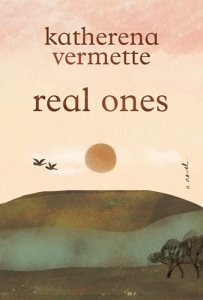
I’ve read The Break and The Strangers, the first two novels in a trilogy by Vermette about the Strangers, a Metis family in contemporary Winnipeg. I fully intend to read 2023’s The Circle, the third of these linked stories, but since the emotional content of these books can be really intense, I put off picking it up. Instead, I read Vermette’s newest novel, Real Ones, which is like the Stranger series in that it is about the lives of a Metis family in Western Canada, but has a much lighter tone and deals with less emotionally shattering events.
Real Ones is the story of June, a university professor, and her sister lyn, an artist. Both are Metis, raised by their Metis father and their white mother. Both girls bounced around a bit between households after the families split, but for the most part, June lived with her father and lyn lived with mother Renee. Perhaps because of this, while June still has a relationship, though not a close one, with Renee, lyn and her mother are completely estranged.
Just as June takes a job that will bring her back from BC to Winnipeg and closer to her family, scandal hits: Renee, whose heritage is Quebecois on one side and prairie Mennonite on the other, is outed after years of falsely claiming a Metis identity and making art inspired by indigenous designs. She has even gone so far as to work under the name “Raven Bearclaw” and to borrow stories from her ex-husband’s background to add colour to her own claims of indigeneity. Now that the story is in the press, Renee is part of the growing number of artists discredited as “pretendians” for claiming an heritage they don’t have, while her daughters — the “real ones,” ie the ones with real Metis heritage — are left to deal with the fallout.
I loved the main characters, the conflict, and the vivid cast of background characters in this story. I was hoping for something a bit more dramatic in terms of a climax and resolution to the main storyline, but perhaps that was never where this book was going. It feels like a contemporary slice of Canadian Indigenous life, less emotionally intense and shattering than The Break and the novels that followed it, but just as connected to big and important questions.
June 27, 2025
The Pretender, by Jo Harkin
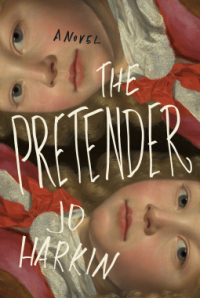
This historical novel, which imagines the life of the man known to history as Lambert Simnel, pretender to the English throne, was utterly absorbing and is one of my favourite books of this year so far.
What we know from history about “Lambert Simnel” is not much. He was the figurehead of a short-lived rebellion against Henry VII in 1487. The Yorkist rebels who wanted to unseat Henry claimed that Simnel was really Edward Planagenet, the son of the late George, Duke of Clarence, rightful heir to the throne (despite the fact that the real Edward was safely in prison under Henry’s control at the time — there seems to have been a suggestion that the “real” heir, Simnel, had been hidden away with a humble family in the countryside while the imprisoned Edward was actually the fake). Simnel played no leading role in the rebellion, being only about ten years old (this novel makes him a little older, but still basically a child) and, unusually for royal pretenders, he was pardoned and reportedly given a job in the royal kitchens, as suited his humble background. Then he disappears from the historical record.
With no more than this to go on, Jo Harkin creates a wonderful, vivid, well-rounded life for the boy who begins life as a farm lad named John, becomes a pretender named Lambert Simnel, and is believed by a few (or do they believe it at all? Is it a purely cynical matter of selecting a child who looks enough like the York heir to be credible?) to be Edward, Earl of Warwick. The different worlds Lambert moves through on his strange coming-of-age journey are brilliantly sketched, but this isn’t just an imaginative recreation of a historical footnote. It’s a thoughtful and sometimes heartbreaking exploration of identity — how each of us moves through many roles, many selves, even if we don’t change our names as we travel through life. What’s lost and what’s left behind in each one, and how we are all, in some ways, pretenders.
This was a big, bold, beautiful novel and it will stay with me for a long time.
June 14, 2025
Curiosities, by Anne Fleming
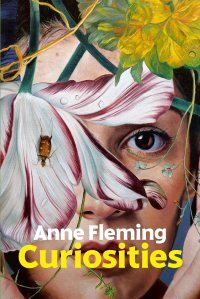
This was a lovely piece of historical fiction told through the format of (fictional) 17th century letters and documents allegedly found by a Canadian researcher named Anne. The blurring of lines between the real Anne Fleming, author, and the fictional researcher Anne whose voice narrates the discovery of these documents, offers a key to understanding the whole book. For while Fleming’s main characters — two village children named Joan and Thomasina, orphaned by plague, who as adults both end up in the orbit of Lady Margaret Long, a scientifically minded woman who has the wealth and position to satisfy her curiosity — are fictional, their world is very real. Several of the minor characters who appear in the story’s pages are real, also. (If I have one quibble with this otherwise beautifully told tale, it’s that I always enjoy an Afterword in which the author of a historical novel points out which characters and events are lifted from actual history; in this case, I had to look quite a few things up myself to see where the blurred lines between history and fiction were drawn).
Most importantly, the conflicts Joan and Tom (the name of Thomasina’s dead twin brother, which Thomasina prefers using) face are real, and rooted in the times they live in. An intelligent, curious, independent young woman like Joan, born in to poverty and further marginalized by the plague that kills the rest of her family, does not have the resources available to a woman like Margaret Long. Instead, intellectual curiosity and independence are qualities more likely to lead to an accusation of witchcraft for a poor woman like Joan. Meanwhile, Tom finds it easier, as further mischance strip away ever person Tom has ever cared about, to reinvent himself. Now he not only uses a boy’s name, but dresses as a boy and begins to identify as a man rather than a woman. This, too, creates fiction out of genuine history: throughout all times and cultures, there have always been a small minority of people who have chosen, out of desire or necessity, to “pass” as members of a different gender than the one that aligns with their sex at birth. Thomasina is not only more comfortable as Tom, but more successful, so that by the time Joan and Tom are reunited as young adults, many things have to be re-evaluated — but there’s hardly time to do that, before external superstition and authority intervene to threaten everything.
OK, I do have one more small quibble with this book, and it’s about Tom’s self-transformation in to a man. He spends several years as a sailor aboard various ships, and finally gives up because, as he says in a letter explaining his past, the men with whom he sailed eventually grew suspicious of the fact that the young cabin boy never grew a beard or seemed to get any older. So he moves to life on land — but there, he attends a boys’ school, has a long-term friendship with another young man, and later goes on an extended sea voyage with many other men, yet his beardless condition never again seems to around any courage. Also, while Tom has an ingenious solution for getting around the problem of young men urinating in front of each other, there is no mention of him having to deal with menstruation, which I thought was an odd omission. So there were a few gaps here in the plausibility of Tom’s story.
Despite those nitpicks, I did find myself absorbed in this book. I loved the language; Fleming does a brilliant job of recreating the style and erratic spelling of 17th century English writers while at the same time keeping the book readable and flowing smoothly for a modern reader. I also loved the openness of the ending, not tying up loose ends but allowing both writer and reader to imagine possible outcomes for the characters.
June 2, 2025
Here, by Heidi Wicks
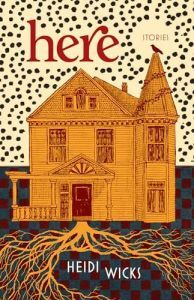
Here is a collection of linked short stories with a broad, ambitious reach that is at the same time wonderfully self-contained. All the stories in this collection are set in the same location — an old house on Circular Road in St. John’s. Like many houses of its vintage, the house at the centre of Home has had many lives, beginning as a palatial mansion for the wealthy, later chopped up in to rental units for a lower class of resident. The stories allow the reader to alight for a few brief moments in different centuries and decades, getting the kind of glances into the lives lived inside the house that you might get while walking past a lighted window at night. Not the full picture by any means, but a series of tantalizing glimpses.
The stories are not told in chronological order, so the reader weaves back and forth in time, which adds to the feeling that we are only catching isolated moments rather than a continuous story. We can see threads of that story that connect from one generation to the next, as we learn of an early character’s fate in a passing mention decades later. But there are also characters who disappear from the story and we never find out what happened to them: sometimes this bothered me, but I decided it was a good sign that these stories intrigued me enough to leave me wanting more. Leaving some stories unresolved, some fates unknown, feels very much in keeping with the broader themes of this collection.
As is always the case in a short story collection, some pieces are stronger than others, and some resonate more with a particular reader. For me, I felt that the stories set in the present day and the recent past came alive with more vivid details than the ones that were further removed in time, but every story has something in it to enjoy. This is a collection of well-crafted stories where the “high concept” of setting them all within a single location pays off beautifully.
The Mighty Red, by Louise Erdrich
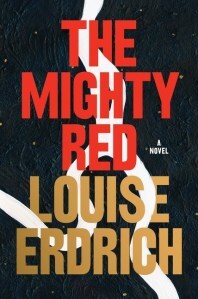
Once again, Louise Erdrich writes a beautiful, poetic, compelling novel. The “mighty Red” of the title is the Red River, and the story takes places in the Red River Valley in North Dakota, in a farming community dominated by one crop — sugar beets — with the attendant environmental damage that comes with exhausting the soil with a single crop on an industrial scale and bombarding the earth with pesticides to keep it growing. Amid this bleak vision of modern large-scale farming, Erdrich’s characters are just people living their lives. There’s high school jock Gary, traumatized by his role in a tragic accident; Gary’s parents, who own a giant sugar beet farm; Metis truck driver Crystal who works for Gary’s parents; Crystal’s daughter Kismet, who Gary is in love with; Bev, who owns the bookstore; Bev’s son Hugo, who’s in love with Kismet — and those are just a handful of the vivid cast of characters populating this book.
This one took me awhile to get into because I had trouble believing some of the characters’ actions, particularly Kismet’s choices. They didn’t seem authentic or believable to the girl she was depicted as being. Also (and I do find this often with Erdrich) dialogue is written more for poetic effect than verisimilitude — she writes a lot of sentences that capture a moment or a feeling effectively, but it’s hard to imagine real people actually saying them out loud.
Despite all this, I persevered with this book and I’m glad I did. It is beautiful and lyrical, and even though I still didn’t really believe Kismet’s initial choice was realistic, I did eventually find that most of the characters became real to me and I cared about them. But probably what will stay with me longest from this book is not anything to do with characters or plot — it’s a short passage about a plant called lambsquarters (also known, Erdrich tells us, as pigweed, baconweed, wild spinach, and other names):
They’d sprayed proactively, pre-emergence, using the big guns. But lambsquarters was back…. In some places, lambsquarters is considered the Prince of Greens, one of the most nutritious greens ever analyzed; it was one of the earliest agricultural crops of the Americas…. The rough-cut men were preparing to eradicate one of the most nutritious plans on earth in favor of growing the sugar beet, perhaps the least nutritious plant on earth. Evolution thought this was hilarious.
A Beginner’s Guide to Breaking and Entering, by Andrew Hunter Murray
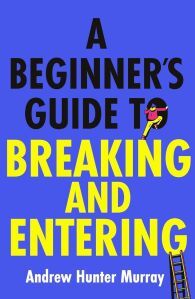
This is definitely my favourite mystery novel that I’ve read this year. I’m already a fan of Andrew Hunter Murray from his podcast, No Such Thing as a Fish, that he does with other members of the writing staff from the TV quiz show QI, but I hadn’t picked up his other books because they seemed to be a bit futuristic-dystopian and, nope, can’t read anything dystopian these days.
However, the premise of this one — very much set in the present-day real world, so only lightly dystopian! — grabbed me right away. The first-person narrator of the story keeps a roof over his head by breaking and entering (though entering without breaking is actually the preferred way to do it) — staying in the homes of wealthy people while they’re away. He doesn’t steal or vandalize; he just takes advantage of unoccupied real estate, and figures his is a pretty victimless crime.
But just as he meets up with a group of other young people doing the same thing, they stumble into a situation they can’t just walk away from. A man is murdered in a house that they’re illegally occupying, and they’re unable to get away quickly enough without leaving a trace. Rather than fleeing the country, the trespassers decide to try to solve the crime themselves, so that if the police do track them down, they’ll have information to offer rather than being suspected of the crime themselves.
It’s a bit of a silly premise but the sharp, funny narrative voice makes this compelling, and I found it hard to put down.
Comedy Sex God, by Pete Holmes
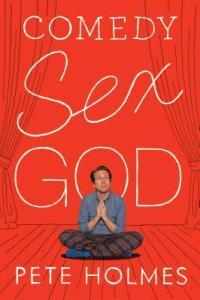
I’m still not sure what the title of this book is. It looks like it could be describing Pete Holmes as a comedy sex god, which is very funny (and I think not the way he would choose to describe himself), but in reading the audiobook he puts in the commas, and the book is indeed about comedy, sex, and God. Presumably the ambiguity is intentional.
I only became aware of Pete Holmes as a comedian recently, and after hearing him talk a little about his background growing up evangelical, I was eager to read (or listen to, actually) his memoir. (If you’re going to read a comedian’s memoir, always get the audiobook). The first chapters tell a very honest and funny story about young Peter growing up in church, being deeply committed to his faith, getting involved in stand-up comedy, marrying young like you’re supposed to do when you’re a good Christian, and then gradually coming to question everything when his wife leaves him for another man.
It’s very cool that after leaving the church, Pete found that he still had a hunger for spiritual things, and that he doesn’t look at his Christian upbringing as a bad thing or a waste of time; though he has his criticisms of evangelical Christian, he’s very much of the “there are many paths towards truth” persuasion. That being said, he found his own spiritual path through doing magic mushrooms, meditating, and following the teachings of Ram Dass, and once he gets deeply into that part of the story, it does get a bit less funny. It’s hard to make anyone’s spiritual journey, regardless of the path they’re on, as funny as the story of your life falling apart. But this was interesting and often very funny to listen too, even if there was a bit more guru-talk at the end than I was up for.



